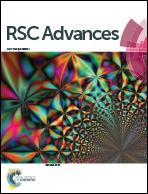Effects of hydrogen bonding between MWCNT and PPS on the properties of PPS/MWCNT composites
Abstract
PPS/MWCNT composites were prepared from polyphenylene sulfide (PPS) and hydroxyl multi-walled carbon nanotubes (MWCNT-OH) or carboxyl multi-walled carbon nanotubes (MWCNT-COOH) by the 1-chloronaphthalene blending method, and the effects of noncovalent interaction between PPS and fillers on the properties of the composites were studied. It was found that MWCNT-COOH could be easily dispersed into PPS, which effectively improved the electrical conductivity and mechanical properties of PPS. With the increase of MWCNT-COOH content from 0.5 to 5 wt%, the conductivity of the PPS/MWCNT-COOH composite rose from 8.8 × 10−3 to 0.35 S cm−1, and the breaking strength and tensile modulus achieved the maximum values of 2189.5 MPa and 294.3 MPa, respectively, when the MWCNT-COOH content was 2 wt%. However, the dispersion of MWCNT-OH into PPS was relatively difficult, and the PPS/MWCNT-OH composite displayed low electrical conductivity and weak mechanical strength. It was concluded that the excellent mechanical properties and electrical conductivity of PPS/MWCNT-COOH were mainly attributed to the strong hydrogen bonding interaction between the carboxyl and sulfide.


 Please wait while we load your content...
Please wait while we load your content...